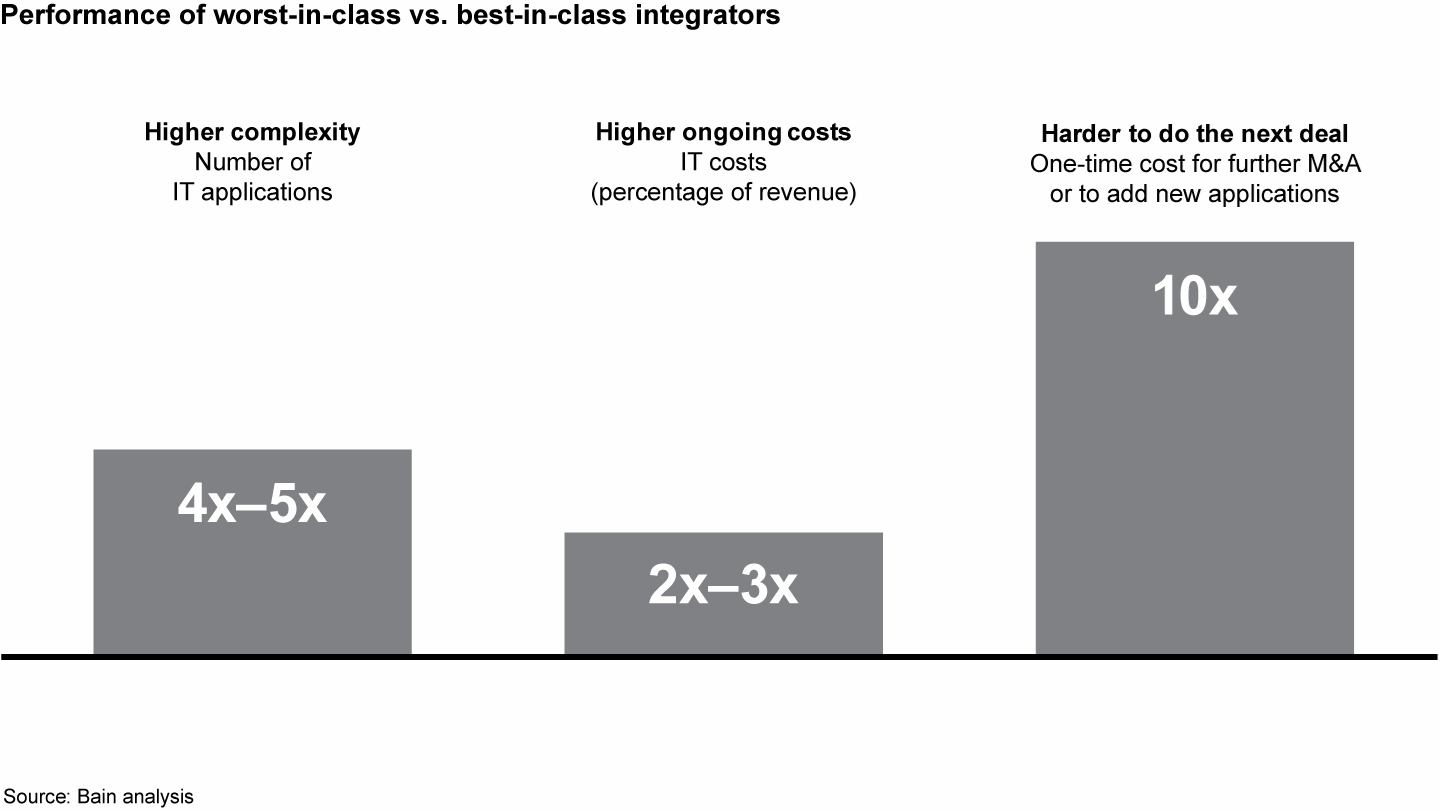Many companies went into survival mode through 2020. They put projects on hold, cut down on expenses, and for many, mergers and acquisitions (M&A) were out of the question. As it becomes safer for companies to open their front doors again, M&As are taking off at an incredible rate. $82.8 billion worth of deal closes occurred in the first half of 2021, exceeding the average of the last five years.
When closing an M&A deal, you need to consider the IT strategy between your business and those you are merging with. The early stages of an M&A are when failure is most often lurking around the corner.
An integration requires numerous components of both business’ technology stacks such as operating systems, applications, coding languages, and programs. Bringing together scattered systems in one organisation can be quite the undertaking. Completing a similar exercise between two organisations can add to the complexity.
Starting your M&A initiative on the foundation of systems integration provides you with the building blocks for IT success. Furthermore, the systems integration you complete in your next M&A could become the blueprint for ensuring IT success in your future mergers.
Why do you need systems integration in an M&A?
You must consider the IT element when merging with another business - and systems integration is a key method of ensuring that any business’s systems work more effectively together. Systems integration in M&As combines the best aspects of both businesses' IT, so otherwise disconnected systems can communicate and share data.
Among the benefits of systems integration in an M&A include:
- Modernising legacy IT systems: Older businesses with legacy systems can obtain modern systems without starting from scratch.
- Access to new software platforms: An acquiring company can leverage the software platforms of another company to unlock new digital strategies.
- Improve customer experience: How an acquiring company leverages new systems and software can change the customer experience.
Old and new systems must communicate efficiently for organisations undergoing an M&A. For example, refreshing legacy systems is a common argument for systems integration in M&As. The process ensures that data in legacy systems can serve your company without you needing to create an entirely new platform.
Another reason systems integration can be beneficial in M&As is because of the data entry time reduction when integrating systems. Instead of separate systems, companies will use one system for the entry of data, and that data will be automatically shared between systems, reducing duplication and administrative costs, and speeding up operations.
Choosing which systems to leverage from each company
Seventy per cent of integrations fail at the beginning of the process. So, it is integral that you prioritise which systems you will leverage from each company. You also need to decide what platforms to keep from each.
When prioritising specific integrations, you need to consider whether or not they will benefit the merger. Some companies spend too much time merging low priority platforms such as email, which often do not provide any advantage when integrating first. (Don’t get me wrong, email is important, but everyone being on the same email system does not actually increase efficiency or reduce headcount)
Instead, you might focus on merging larger systems that deliver the most value to the business. The merger might see one company migrate and adopt the complete tech stack of the other company. Or, both companies may take a best-of-breed approach and combine the best systems from them both.
For example, one company might have an excellent sales management platform while the other has a better inventory management platform. When these two companies merge, they need to select the apps, platforms or systems that will best serve them both.
“77 percent of executives state that their technology architecture is becoming very critical or critical to the overall success of their organization.” Accenture.
How APIs support integration in an M&A
When two organisations merge, systems integration becomes an important consideration. Application Programming Interfaces (APIs) provide a platform for your systems and data across both companies to communicate with each other.
The API is an interface that allows a system to communicate with the other systems in its eco-system. APIs can help you unify disparate systems, through enabling access, monitoring, and management of the systems via a single point of entry. Without APIs, systems integration teams would have to do more work to implement integration.
Imagine you have two systems that need to work together; let’s say they are your CRM and your billing system. The billing system needs to access data from your CRM. APIs can make data securely available from these systems, so both of them can easily share data without human intervention.
A bank might store customer information in one system and acquire a company that stores customer data on another. Integrating these systems via APIs connects them and ensures both companies can access customer data when they merge.

How APIs benefit systems integration in an M&A
APIs standardise data between different systems and deliver the following long-term benefits:
- Reduced maintenance costs: APIs ensure your systems communicate and share data without administrative staff combining and managing data between systems. Data handled manually leads to multiple systems with duplicate data and accounts, which increases maintenance costs.
- API re-use in future M&As: Organisations can leverage the same APIs (alongside creating new ones) for future M&As. You should think of integration in M&As as a long-term investment. This integration will help to reduce the workload of integration with future M&As.
- Improve time to market: Systems can use pre-existing code to quickly and easily send and receive information without additional coding. Systems integration shortens time to market as you can develop new products and services quickly.
- Securely share data between organisations: Security can become a major concern when undergoing a merger. One company may have weak security that hackers can exploit to access the other. APIs can provide a secure framework to ensure both companies can merge and share data without the risk of compromise.
Your systems integration strategy should also consider that your business will improve and grow over time. Companies need to consider the long-term benefits of systems integration and not just improving systems at any given point in time.
“A future-ready, connected organisation will have the capabilities to quickly respond to market signals and pivot to capitalise on opportunities as they arise. Future success means being connected to customers, to market dynamics, to employees, to channel and business partners and aligning across the front, middle and back offices.” KPMG.
How Creative Folks supports systems integration in M&As
When we work with customers who need integration, we examine their applications and the underlying services these applications offer. There will be an API of sorts in many cases. Sometimes the vendor may have utilised this for functional enhancements. For example, an older system may not have a good API, but it may be enough to improve upon.
Creative Folks’ expertise lies in understanding the ecosystem, working out what is possible, then presenting options and guiding you through the pitfalls. Most companies could be doing more with the systems they already have if they knew how to leverage their existing APIs.
Our expert team holds a deep passion for systems integration. We can connect your business systems and bring significant benefits to your internal team and your customers. We offer consulting services as well as full-service solutions. Our expert team works closely with you to understand your current ecosystem, discuss solutions, implement these solutions and maintain them for you.
Visit our Systems Integration page for more on our capabilities.




 Previous
Previous


